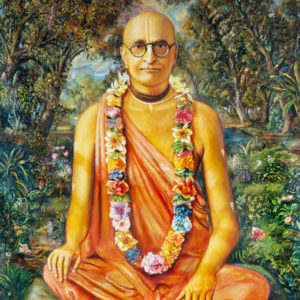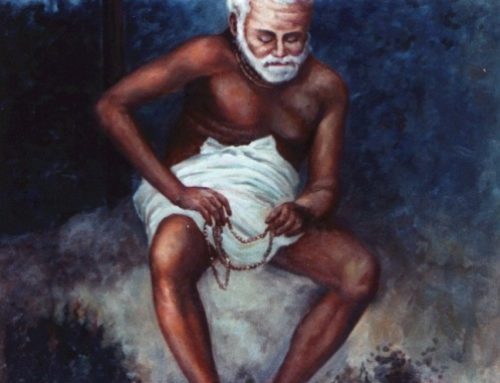Source: Sri Bhaktisiddhanta Vaibhava
 Even while executing his vow, Śrī Siddhānta Sarasvatī occasionally went outside Māyāpur for preaching, especially to attack the apa-sampradāyas for misleading people with their bogus interpretations and practices. He particularly agitated the smārta-brāhmaṇas and jata-gosanis (caste Goswamis) by insisting that the position of a brāhmaṇa and post of guru are not hereditary professions. Such assertions were intolerable to the smārta-brāhmaṇas and jata-gosanis, who were keeping a stranglehold on Hinduism in Bengal by maintaining that only persons born into families of supposed brahminical lineage could be counted as genuine brāhmaṇas or gurus, and who were not at all happy with these “new” ideas that contested their nigh unquestioned authority and threatened to despoil their ancestral business of cheating.
Even while executing his vow, Śrī Siddhānta Sarasvatī occasionally went outside Māyāpur for preaching, especially to attack the apa-sampradāyas for misleading people with their bogus interpretations and practices. He particularly agitated the smārta-brāhmaṇas and jata-gosanis (caste Goswamis) by insisting that the position of a brāhmaṇa and post of guru are not hereditary professions. Such assertions were intolerable to the smārta-brāhmaṇas and jata-gosanis, who were keeping a stranglehold on Hinduism in Bengal by maintaining that only persons born into families of supposed brahminical lineage could be counted as genuine brāhmaṇas or gurus, and who were not at all happy with these “new” ideas that contested their nigh unquestioned authority and threatened to despoil their ancestral business of cheating.
Although still secure with the support of mass misoneism born of centuries of ingrained tradition, the false brāhmaṇas felt themselves under increasing pressure and hence marshalled themselves to protect their interests. In August 1911, suspending their mutual mistrust, the smārta-brāhmaṇas and caste Goswamis arranged a meeting at Sujangar village, in Midnapore District of Bengal. Under the chairmanship of Śrī Bipina Bihārī Goswami they declared their anti-devotional manifesto, soon thereafter published as Pūrva-pakṣa Nirāsane (Refutal of the opposing argument):
Unless born in a brāhmaṇa family, a Vaiṣṇava is disqualified from worshiping śālagrāma śilā and conferring initiation. By accepting disciples, Narottama dāsa Ṭhākura and Śyāmānanda Prabhu had thus contravened śāstra; Caitanya Mahāprabhu presented Raghunātha dāsa Gosvāmī with a Govardhana-śilā because as a śūdra he was disqualified from śālagrāma-śilā worship; Worship of Govardhana-śilā has no śāstrīya basis and hence is merely conventional or sentimental; Only those injunctions of Hari-bhakti-vilāsa that do not contradict traditional smṛtis are to be followed.
As intended, this broadside against Hari-bhakti-vilāsa and the conclusions of hallowed ācāryas caused much disturbance and doubt, particularly in the minds of the many Vaiṣṇavas in the locality of the convention, whose gurus’ teachings were the targeted pūrva-pakṣa. Yet the gauntlet that had been thrown down was not merely a local matter—its reverberations resounded throughout the Vaiṣṇava community of Bengal and Orissa. In response, the proponents of pure Vaiṣṇavism formed the Gauḍīya Vaiṣṇava Dharma–saṁrakṣiṇī Sabhā (Assembly of protectors of Gauḍīya Vaiṣṇavism) under the chairmanship of Śrī Viśvambharānanda-deva Goswami, head of the Śyāmānandī sect.
The three-day public event beginning on 8 September 1911 in the village of Bālighāi Uddhavapura, close to Sujangar, was organized by Śrīpāda Bhakti Tīrtha Ṭhākura, a disciple of Śrīla Bhaktivinoda Ṭhākura, and was sponsored by the Maharaja of Mayurbhanj, whose family traditionally had ruled on behalf and as disciples of the Śyāmānandī gurus. Śrīla Bhaktivinoda Ṭhākura was expected to be the main speaker, but due to severe rheumatism was unable to attend. In frustration he cried out, “Is there no one in the Vaiṣṇava world who can reply to these people, and by presenting scriptural evidence and logic put a stop to their lowly activities?”
Taking up the challenge, Śrī Siddhānta Sarasvatī penned a manuscript entitled Brāhmaṇa o Vaiṣṇavera Tāratamya-viṣayaka Siddhānta (Conclusion concerning the comparison of brāhmaṇas and Vaiṣṇavas). Śrīla Bhaktivinoda Ṭhākura had been in such pain that he was unable to rise from bed, but when Śrī Siddhānta Sarasvatī read this essay to him, he spontaneously sat up and joyfully congratulated Śrī Siddhānta Sarasvatī, declaring confidently that by such arguments the darkness of the smārta doctrine would soon be dissipated.
The day after he arrived Śrī Siddhānta Sarasvatī accompanied Śrī Madhusūdana Goswami and Śrī Viśvambharānanda-deva in inspecting arrangements for the meeting. Although smārta paṇḍitas and jata-gosanis had not been invited, a considerable number had arrived from all over Bengal.
Next day, with the acquiescence of all, Viśvambharānanda-deva Goswami accepted the chair of the meeting. Although Śrī Siddhānta Sarasvatī was the youngest delegate present, his reputation was such that it was clear he should be the first to speak. Repeating the conclusions of his essay, he began by citing numerous scriptural references in approbation of brāhmaṇas. This delighted his antagonists, most of whom were unaware of many of the passages he quoted. But their glee turned to wrath when Śrī Siddhānta Sarasvatī shifted tack to compellingly refute the smārta position with his unerring logic and mastery of scriptural lore, presenting overwhelming evidence for ascertaining who is actually a brāhmaṇa or Vaiṣṇava and asserting that only a Vaiṣṇava is a true brāhmaṇa, superior to those who claim brāhmaṇahood by birth, and that Vaiṣṇavas should be gurus of seminally-produced brāhmaṇas, not vice versa.
At the conclusion of the first day and on the second, the uninvited smārta constituency was allowed to speak. The meeting climaxed with a two-hour allocution by Śrī Siddhānta Sarasvatī, which recapitulated the genuine Vaiṣṇava position and left the rivals with nothing further to say. As the smārtas and jata-gosanis slinked away, Viśvambharānanda-deva Goswami affirmed Śrī Siddhānta Sarasvatī as the champion of the meeting, a conclusion echoed by thousands of cheering mouths. Expressing awe at the erudition of Śrī Siddhānta Sarasvatī, Madhusūdana Goswami declared him an avatar of Śukadeva Gosvāmī, and later conveyed deep gratitude to Śrīla Bhaktivinoda Ṭhākura for preparing a mighty ācārya in the personage of Śrī Siddhānta Sarasvatī.
This first of Śrī Siddhānta Sarasvatī’s major public triumphs was signalled by jubilant crowds rushing to take dust from his lotus feet. Śrī Siddhānta Sarasvatī never allowed anyone even to touch his feet, let alone take dust from them, but despite his resolve to maintain a humble demeanor, a swell of people were now crushing in on him, equally determined to get his precious foot-dust. The guards pacified the clamoring throngs, took Śrī Siddhānta Sarasvatī aside, and washed his feet. After adding several extra pots of water to the foot-wash, they distributed it to the eager mass. And fearing attempts to harm him, they placed Śrī Siddhānta Sarasvatī under police protection.


